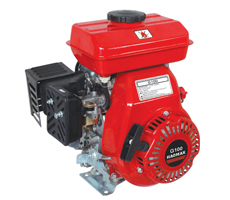 Honda’s G100 engine is used in a wide range of small-engine equipment, including lawn care, construction, and agriculture devices for both the consumer and professional markets. No matter what your engine is attached to, this guide will walk you through using this motor and solving common problems.
Honda’s G100 engine is used in a wide range of small-engine equipment, including lawn care, construction, and agriculture devices for both the consumer and professional markets. No matter what your engine is attached to, this guide will walk you through using this motor and solving common problems.
Safety
Like all internal combustion engines, the G100 produces carbon monoxide when it burns fuel. When used in confined spaces, this gas can collect, causing asphyxiation. Always move the engine to an outdoor location away from buildings before starting.
The fuel tank should also never be refilled while running. Wipe up any spilled fuel immediately.
Things to Check Before Starting the Engine
Check the oil level: With the engine level, remove the oil filler cap/dipstick, located at the bottom rear of the motor, wipe it off, and reinsert it into the motor without screwing it in. Pull it out and make sure there is oil on the hash marks on the dipstick. Add more oil as needed; Honda recommends 10W30 for this engine.
Check the fuel level: Open the fuel tank and make sure there’s fuel inside. When filling, never add fuel past the strainer inside the filler neck.
Check the air cleaner: Remove the wingnut from the filter cover, located on the side of the engine near the starter handle, then take off the cover and filter. Replace the filter if it’s damaged. If the filter is dirty, clean it using soapy water. Once dry, soak the filter in clean engine oil, squeezing out any excess. Reinstall the filter, cover and wing nut.
Check the equipment: Make sure there aren’t any fluid leaks, and make a general inspection of the device the motor powers. For more information, check the equipment manual.
Starting
- Turn the fuel valve, located behind the air cleaner, to “ON.”
- Turn the engine switch, located directly opposite of the fuel valve, to “ON.”
- Move the throttle lever, located below the fuel valve or on a remote control on the equipment handle, down slightly.
- If the engine is cold, move the choke lever, above the air cleaner, all the way to the right to close it. If the engine is warm, move the lever to the left to open it.
- Gently pull the starter grip until you feel resistance, then give it a quick pull to turn over the motor.
If the choke was closed, gradually open it as the motor warms up. The throttle should be set to the position specified in the equipment manual: some equipment needs the engine to run on full throttle, while other equipment may need the throttle to be just partially open.
Stopping
- Move the throttle lever up to the top position.
- Turn the engine switch to “OFF.”
- Turn the fuel valve to “OFF.”
Troubleshooting
Engine Won’t Start
- Make sure the choke lever is closed if the motor is cold, or open if the engine is warm.
- Make sure there is gasoline in the fuel tank and the fuel valve is in the “ON” position. If the fuel is old, replace it with fresh fuel.
- Check the spark plug, replacing it if it is damaged, and cleaning and adjusting the gap to spec. If it’s wet, the engine is flooded. Wipe off the plug, reinstall it, and try starting the engine.
Loss of Power
- Make sure the throttle lever is in the correct position. Check the equipment manual for recommendations: some devices need full throttle, while others should run at partial throttle.
- Check the air filter and clean if clogged.
- Check the fuel. If it’s old or bad, drain it from the fuel tank and carburetor.
Draining and Replacing Fuel
If old fuel is causing problems, use the following method to drain the tank and carburetor:
- Place a container underneath the carburetor.
- Close the fuel valve.
- Remove the sediment cup, located directly below the fuel valve.
- Open the fuel valve. The gas will pour out of the opening left by the sediment cup.
- Once the tanks has drained, refit the sediment cup, making sure the o-ring is properly seated on the cup’s top edge. Close the fuel valve and add fresh fuel to the tank.
Getting Parts for the Honda G100
When you need parts for your Honda G100, go to www.hondalawnparts.com. We’re a certified Honda Small Equipment dealer, carrying a full range of OEM parts for Honda’s small engines. We have factory parts diagrams available to make it easy to locate the correct part, and we can ship parts to any address in the U.S. and Canada.
